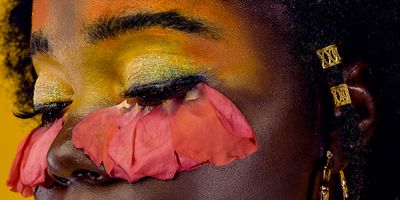Check out 'AKANTUNSE', a Visual Celebration of African Mythology
The speculative photo series by Zambian collective Kabumba, re-imagines nine significant figures in African mythology, cosmology and folklore.
Kabumbais a Zambian multimedia curatorial platform based in Lusaka that curates African visual art that seeks to push the limits on existing narratives within African art. AKANTUNSE is Kabumba's latest project—a fun and speculative multimedia project which celebrates nine figures in African mythology, cosmology and folklore.
We reached out to creative director, Chanda Karimamusama, who worked alongside photographer Kabelenga Phiri and make-up artist Mary Mthetwa, to find out what how AKANTUNSE came together.
What inspired Kabumba to create AKANTUNSE?
With AKANTUNSE, we really wanted to affirm the creative media and design possibilities for imaginative African storytelling and speculation. Drawing inspiration from African folklore and mythology, we attempted to preserve various African cultural assets by reconciling the old with the new. We used various digital and IRL [in real life] media tools to create a new and relatable sort of urban tradition of storytelling.
We also really wanted to demonstrate (through the subtle politics of this project) the historic prowess as well as contemporary relevance of African storytelling in expansively imaginative expression and exchange.
Why these specific nine figures of mythology?
We specifically chose to celebrate Yemaya, Nyami Nyami, Yumboe, Dzivaguru, Nyau, Oshun, Makeda, Anansi, and Obayifo for a number of reasons. I'll try to narrow them down to three:
Each of them are important, powerful, and magnificent figures appearing in the African imagination on the African continent and diaspora. This was important for us—that our selection of figures was representative, historically relevant, and pan-African.
We really wanted our selection of figures to be reflective of the politics of African artifacts like these, their corresponding knowledge systems, and how they've chronologically informed our identities and the possibilities we attribute to those identities.
Lastly, we considered which figures had the poorest online index, which figure narratives had suffered discoloration overtime, and which figures were most relatable. Each one is so unequivocally badass!
Why do you think preserving African folklore or mythology is important as Africans?
It's because you have no idea where you're going without the full knowledge of where you're coming from. Less implicitly, the cultural memory of our history has traditionally been oral. Without contemporary documentation, speculation, or tangible knowledge systems of our own volition, our collective and disparate stories disappear, or worse, they become twisted and they lack depth.
View the photos from AKANTUNSE below:
- Watch Samba Yonga's TED Talk on an 'African Superhero Curriculum' - OkayAfrica ›
- A Tale of Ghana’s Fabled Fortune - Okayplayer ›
- This Creative Couple Is Encouraging People to Read African Mythology | OkayAfrica ›
